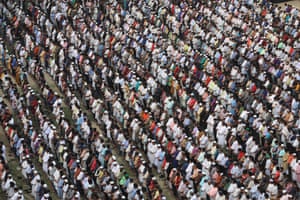Image; A vigil in Isamabad to pay tribute to the Sri Lankan blast victims. Photograph: Aamir Qureshi/AFP/Getty Images.
Are there lessons we can learn from last week’s atrocities in Sri Lanka?
The funerals are over, the investigation continues and the blame game begins and media attention shifts away. This time the victims were Catholic worshippers and patrons of luxury hotels in Sri Lanka. A month ago they were Muslim worshippers in New Zealand, shot by a white supremacist as they prayed.
It is almost two decades since attacks launched by al-Qaida on New York, the Pentagon and Washington announced a new era of mass-casualty terrorism. Such violence has long been with us all, of course. Terrorism in its modern form can trace its roots back to the 19th century. The 1970s saw hundreds of terrorist bombings, shootings and hijackings in the US. The 1990s were bloody, too.
But the era that began with the 2001 attacks brought something else. The rapidity with which we now learn of violence thousands of miles away, the graphic images and testimony to which we are exposed, or seek out, and the unprecedented scale of the violence combine to give an old threat a new immediacy. Terrorism is part of all our lives – as terrorists want it to be. We know much more about extremist violence than we have ever done. So what can we learn from this latest tragedy?
Our view of terrorism is too restricted
Every time there is a new attack, there is surprise. One explanation is that we suffer from a form of willed amnesia about violent extremism. Perhaps because terrorism is so rarely experienced personally it often seems that the level of fear we feel is determined by little more than the last thing that we read or saw that involved terrorists. So, for many people, the background to the Sri Lanka bombings was the expulsion of Islamic State from its last redoubts in Syria last month. Thus the sense that this was somehow unexpected.
The loss of its last territories was a major defeat for Isis. It will find it much more difficult to organise terrorist attacks in its heartland and further afield without the extensive infrastructure, lucrative opportunities for taxation and looting, and a relatively secure enclave where volunteers could be trained and operations planned. Its failures are now blatant. The international boundaries it boasted of smashing forever remain. Previous caliphates spanned centuries. This one lasted less than five years. But though the group’s ideology and attraction have been undermined, it has not disappeared.
No one with any knowledge of how extremist ideologies evolve would have expected that its complex mix of conspiratorial politics, radical theology, sectarianism and apocalyptic prediction would have lost all power to convince overnight. The bombings in Sri Lanka are bloody evidence of this.
We don’t know when Isis became involved in the attack, but it is very likely that it was instrumental in turning a ramshackle group focused solely on defacing or destroying Buddhist statues in January into one capable of launching last week’s bombings. This means an intervention within the past few months, when Isis’s final territorial defeat was well under way. A deeper understanding of how the group works, grounded in a longer-term perspective, would have prevented false hopes that the hydra was slain.

The same is true of any surprise that such an attack should occur in South Asia. Once, events there were a major preoccupation of western decision-makers. Since the death of Osama bin Laden in Pakistan in 2011, it has disappeared into a news and policy black hole. The multiple militant groups may no longer pose an obvious threat to the west, but it is said 7,664 people were killed in terrorist attacks in the region in 2017. If we had paid more attention in recent years, last Sunday’s atrocities would have been less of a shock.
We still don’t understand radicalism
We know there is no “terrorist” gene. The number of secular attackers over the decades, and the wave of rightwing violence based on “race” or ethnic identity, not faith, suggests that religion is an insufficient answer. Many religious attackers are not observant at the beginning of the radicalisation process. Some aren’t at the end either. There are examples of European extremists who had used drugs, liked nightclubs and had girlfriends before recruitment by Isis who never fully abandoned their previous ways.
The brutally simple response is that there is no single answer.Individuals are drawn into terrorism in the same way they are drawn into all sorts of other extreme ways of behaving. Many routes can lead to the same result. Some of the attackers in Sri Lanka were wealthy and educated. This has surprised some. There is no link between poverty and extremist actions or thinking. Nor is education a predictor. There are extremists with doctorates, and others who are barely literate.
There is also much variation globally. Attackers in Europe have different profiles from those in the Middle East or in the US.
One general rule is that the process of radicalisation is a progressive one, always gradual, though it can be rapid. It usually involves a charismatic leader, a simple idea that resolves a profound personal crisis, a binary narrative that answers a particular grievance, a group of friends, relatives or other associates who reinforce each other’s behaviour creating a feedback loop of greater separation from the rest of a community, society and nation. Few set out to be a suicide bomber. A recent study of Saudi recruits to Isis found that only one in 10 signed up for martyrdom.

Crucially, someone vulnerable to radicalisation at one moment in their life may be much less so just months later. A key element in the explanations of former terrorists for their own actions – as well as in accounts given by Nazi mass killers and others – is that their acts are necessary to head off a catastrophic outcome for their community, that they are an obligation for any rational individual. Combine this with the total dehumanisation of the victims – another product of groupthink, separation and propaganda – and you are already a long way to mass murder, whether in a death camp, through an artificial famine, by a mob armed with knives and axes, or a multiple suicide bombing.
All politics is local, and so is all (successful) extremism
For more than 20 years, our vision of Islamic extremist atrocities has been distorted by the events of 9/11, which involved a team of attackers from the Middle East striking in the US. But terrorists rarely come from overseas to attack, as they did then. The vast majority launch their operations close to where they live, often only a short journey in a car, train, rickshaw or by foot. In Afghanistan, internal intelligence assessments have shown that most attacks were made by people living less than a mile from their target.
The Sri Lanka bombings show this. We know the identities of four bombers. The leader of the network was from a village three hours’ drive from Colombo, the capital, where all but one attack occurred. Two brothers lived in an upmarket neighbourhood of the city, and may well have been familiar with the luxury hotels they bombed. The fourth had studied in Britain and Australia, but lived in the capital too.
Even when bombers succeed in reaching jihadist groups to get training, their success often depends on the advantages that come with attacking targets on their home turf. As Scott Atran, an anthropologist and expert in extremism, noted in the Guardian last week, all but one attack by Isis in Europe in 2014 failed owing to a lack of local contacts. When, a year later, Isis sent operatives into Europe who could engage an extensive network of overlapping and pre-existing social ties among families, friends, workmates and petty criminal bands clustered in particular neighbourhoods, the result was carnage.

The Muslim community in Sri Lanka has long been marginalised politically, and often economically too. In recent years there has been a sharp rise in sectarian tensions, mainly a result of the emergence of militant Buddhist groups.
Then there is the legacy of 26 years of a brutal civil war. Though this was fought out on ethnic, not religious, lines, it nonetheless left a legacy of violence and trauma which should not be underestimated. The island nation was fertile ground for Isis. Its leaders know that a global ideology only becomes truly dangerous when it is adopted by local actors. We should remember that too.
Counter-terrorism is local too
To say that terrorist attacks depend on security failings is a truism. But the shortcomings that allowed the Easter Sunday bombings in Sri Lanka appear egregious. Veteran insurgents returning from Syria were not watched, let alone detained or questioned. Suspects linked to a makeshift training camp raided in January were not investigated, despite the seizure of detonators and explosives. At least one of the bombers was arrested, then released. Police were told informally about the suspects by Indian counterparts as early as December. Three formal warnings in April were not passed on to key decision-makers.
There are reasons for these shortcomings. The Sri Lankan state is deeply dysfunctional and its security establishment riven by faction and feuds. The prime minister and the president are barely speaking. There were even rows over who would join national security committee meetings in the hours after the bombings. The same divisions run through the police, the military and the intelligence services.
Intelligence agencies around the world, like armies, reflect the strengths and weaknesses in any given society or state. A rotten political system will have rotten security services. If most terrorism is a local phenomenon that is networked into a bigger global system, so is counter-terrorism.
Isis knows this. Such organisations are dynamic, mobile and innovative. The extremists are opportunists, exploiting vulnerabilities, then moving elsewhere to find others.

Violent Islamic extremism will fail, so violent Islamic extremism will continue
The fundamental problem for Islamic militant groups is that every time they have tried to seize and hold land – their ultimate aim, for without the caliphate the new society they dream of cannot be created – their efforts have ended in failure.
Many jihadi strategists recommend spectacular attacks to frighten enemies, mobilise supporters and polarise those in between. This will weaken state structures sufficiently for them to be destroyed, allowing a chaotic and bloody vacuum that can be exploited to build a new Islamic entity.
The challenge for the militants is that this can only succeed in places where the state is already weak – Iraq after the 2003 US-led invasion, Afghanistan in the 1990s, the Sahel – the transition zone between the Sahara in the north and the African savannahs in the south – today. Anywhere else, militants may have initial success, even seizing territory, but will eventually be rejected by local populations and rolled up by security services.
The recent Isis so-called caliphate is a good example of what goes wrong. Isis made too many enemies, too quickly. Importantly, it could never do otherwise, given the nature of its ideology. The group’s obsessive hatred of Shia Muslims precluded expansion into areas where Sunni Muslims were few. Its brutality meant loyalty was either coerced or gained from shattered, traumatised local communities who feared their own government more than the jihadists. The threat they posed could never be tolerated by regional and neighbouring states, while the long-range attacks against the west prompted an inevitable reaction that mobilised formidable firepower. Taken together, this meant the caliphate was never likely to survive for very long.
This is the pattern since modern Islamic militancy emerged in the Middle East in the early 1970s. Local campaigns have periodically burst on to the international stage, sometimes taking a central but transient role in global events, but always being dispatched eventually to the shadows of the periphery. This is where al-Qaida now lurks. It is where Isis is heading.
So the good news is that Islamic militancy will not achieve a breakthrough any time soon. The remaking of the world dreamed of by extremists will not happen – happily for everyone else, wherever they are.
But this means bad news, too: the extremists’ violence will continue to bring horror into the lives of innocents for the foreseeable future.
Jason Burke is the author of Al-Qaeda, The 9/11 wars and The New Threat, published by Bodley Head
